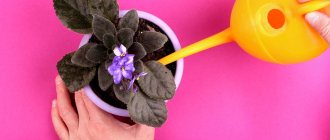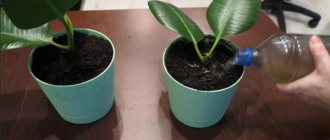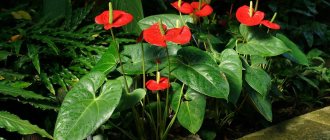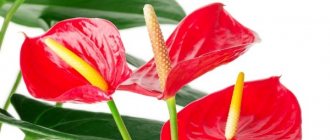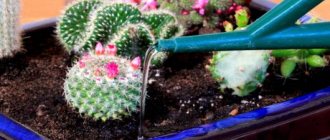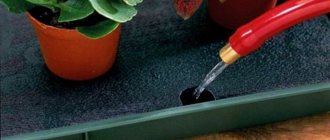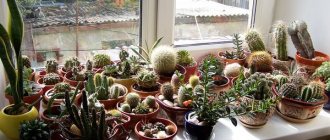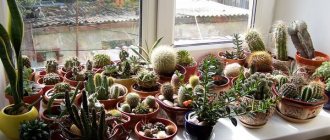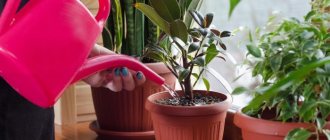Anthurium is a tropical plant with a flower in the form of an elongated cob with a bright glossy cover. It can have different shapes and different colors.
Dear readers! For you, we have created communities on social networks in which useful articles and interesting ideas are published several times a day! Subscribe and receive useful content in a convenient format! Different types of anthuriums can be either epiphytes (growing on tree bark) or semi-epiphytes (growing next to trees in fallen bark, leaves and branches covering the soil).
There are up to several hundred species of anthurium around the world, but only three species are popular among gardeners: Anthurium Andre, Anthurium Crystal and Anthurium Scherzer.
Anthurium is popularly called “Male Happiness”. According to one version, it is named so because the plant in appearance resembles a hot, flaming heart-veil, pierced by an arrow-cob.
How often to water the “Male Happiness” flower?
Due to its tropical origin, anthurium does not tolerate drought , but if you overdo it with watering, the roots will simply begin to rot.
In addition, overwatering leads to the spread of mold. When watering a plant, you need to rely on observations of the flower. If the soil feels dry when you feel it, then it’s time to water the flower.
The temperature in the room is also of great importance. If it is high, then you need to water more often. If the air is cooler, then watering should be reduced accordingly.
Also, a lot depends on the age of the anthurium. A young flower requires more moisture than an older specimen. Like many tropical flowers, the frequency of watering depends on the time of year.
Temperature
The optimal temperature for winter is 18 degrees. Anthurium can withstand temperatures up to 13 degrees, but for a very short amount of time.
If the anthurium in winter (for 1-2 months) is kept at a temperature of about 18 degrees, then it will bloom well the rest of the year.
For the warm period, the best temperature for the flower is 20-22 degrees . But when in summer it rises to 26-30 degrees, plants are watered and sprayed more often and more abundantly.
Watering methods
Most often, gardeners prefer bottom watering, that is, in a tray. This is not the best way for anthurium. Anthurium has aerial roots on the lower part of the stem. They also need to get moisture. Therefore, it is recommended to cover the base of the plant with sphagnum moss.
It retains moisture and thus nourishes these same roots. You can also use mixed irrigation, that is, water the soil directly and add water to the pan.
Important! When watering a plant from above, do not pour water on the leaves, and especially the flowers. This can lead to a deterioration in the appearance of the flower. Droplets of water dry out and leave unsightly marks.
Anthurium is very good at spraying from a spray bottle, while experts advise moistening not the flower itself, but the air around it, especially in winter.
Well, the last way to moisturize is to place a container with a flower on a tray filled with expanded clay and water. Evaporating water moisturizes both the soil and the flower as a whole.
Remember! It is very useful to periodically arrange a “bath day” for anthurium. You can wipe the leaves and flowers with a damp cloth, but be sure to dry all surfaces afterwards. Otherwise, water stains will remain on the flower. Or, the anthurium “bathes” in the shower. This way you can wash off all the dust from it. After this, the procedure for drying the surfaces of the leaves.
Location and lighting
Florist experts say that although anthurium tolerates shade well, it should still be placed in a place well lit by sunlight. In a heavily shaded place, “male happiness” will stop growing and drop its flower stalks.
Direct rays are destructive for this plant; they will leave burns on the tender, juicy leaves. It is ideal if you find a place for your green pet not far from a window facing east or west. North and south windows are completely unsuitable.
If there is not enough natural light in your home, then take care of artificial lighting. For example, buy a special phytolamp; it is inexpensive and consumes little electricity.
In winter, place the anthurium away from the heating system and away from drafts. In summer, take the flowerpot out to the balcony; fresh air and temperature changes between day and night will be very useful for it.
Photo: mocah.org
Geranium: home care, propagation and transplantation
What is orientation to the seasons?
Winter
As a rule, flowers need to be watered much less often in winter. Anthurium is no exception to this rule. Watering is carried out no more than once a week. The main condition for wintering is to monitor the temperature. The tropical beauty simply cannot withstand temperatures below 10-12 degrees, and sub-zero temperatures are out of the question.
Attention! Draft is the worst enemy of anthurium. Under no circumstances should you keep the flower in actively ventilated rooms.
Summer
Anthurium is a very heat-loving flower, and therefore summer is the most fertile time for it.
You can water it more often - up to 2-3 times a week, and 20-30 minutes after watering you need to pour out the excess water that remains in the pan , otherwise rotting of the roots cannot be avoided.
Gentle, frequent misting of the air will be very helpful.
Spring and Autumn
In spring and autumn, you need to carefully monitor the absence of drafts, good lighting and water the flower as needed. If the anthurium is actively growing or has begun to bloom, a little more water is needed.
Transfer
Transplantation is carried out 1 to 2 times a year, depending on the speed of development of the specimen.
The roots of this crop are very fragile, so the plant is simply pulled out of the pot, without touching the coma with soil and roots, and moved to a larger container.
The difference in diameter between the old and new anthurium pot should be no more than 3-4 cm . After transplantation, the anthurium is moistened. Replanting begins when root tips appear in the drainage holes.
What kind of water is needed for irrigation?
Anthurium is very sensitive to water. More precisely to its temperature. Watering it with cold water is strictly contraindicated. Warm water or water at room temperature is ideal. You cannot water a flower with tap water - this will negatively affect its health and appearance. Hard water is also unacceptable for a flower.
Additional Information! It is best to fill bottles with water and leave them at room temperature. It is best to use this water after 3-4 days.
Diseases that occur due to improper watering
As mentioned above, anthurium does not like overwatering. As a result, the root system begins to rot, and with it all other parts of the flower. The leaves of anthurium suffer the most, since they make up the main volume of the flower.
Leaves may darken and become covered with dark spots. This happens to them due to too frequent and abundant watering.- When might leaves become covered with white spots? Most often this happens if the flower is watered with cold and hard water.
- If you endlessly flood a flower with water, it is almost impossible to avoid fungal diseases. They affect both the soil around the plant and the plant itself as a whole. There are several diseases of anthurium. Let's briefly look at some of them.
- Powdery mildew occurs when soil and air humidity are high. Expressed as a white covering on the surface of the plant. It can be treated with antifungal agents.
- Sooty fungi are a consequence of the colonization of leaves by aphids. They live precisely on the waste products of the latter. They are dangerous for the flower because they block any possibility of growth and development for the plant. All parts of the plant are affected. If it was not possible to prevent the process, then it can be stopped by washing the flower with a solution of potassium soap. Complete removal of the affected areas will help to completely get rid of sooty fungus.
- Rust - occurs on the stems and leaves of anthurium suffering from drought. It is expressed by the appearance of dark brown areas on the leaf. Gradually, completely darkened leaves begin to fall off. Wiping with Bordeaux mixture and complete elimination of infected leaves will come to the rescue.
Reproduction
Anthurium propagation occurs using lateral shoots with aerial roots, apical cuttings and seeds.
Anthurium apical cuttings are cut at the beginning of intensive growth (March - May). Each cutting should have at least two leaves and several roots.
For rooting, use a small pot or glass filled with sand or vermiculite (a special mineral sold in the store).
Part of the cut stem is buried in a container and lightly moistened with sand or vermiculite, then placed in an indoor greenhouse. The substrate should not dry out.
Rooting lasts a little more than a month at a temperature of 24 to 25 degrees. As soon as the roots reach 3-5 cm, it is transplanted into soil for anthuriums.
Side shoots with aerial roots are separated from the anthurium during transplantation . They are planted immediately in the ground, watered a little and placed under a film or jar, or in a small greenhouse for complete engraftment. Such plants are cared for as adult specimens.
Fresh anthurium seeds are sown in low and wide containers with light universal flower soil.
The seeds are sprinkled with a little earth (0.5-1 cm), moistened and covered with film, transparent plastic or glass. Seed germination lasts about 2 weeks at a temperature of 20-24 degrees.
Anthurium seedlings are pricked (replanted) several times as they grow . The first time they do this is when they form two (real) leaves. And when the diameter of the bush becomes 5 cm, they are planted in pots. The first flowering of such anthuriums can begin in 3-4 years.
Answers to frequently asked questions
What insects can attack anthurium?
There are several such insects: spider mites, aphids, thrips, root nematodes, scale insects. They suck all the moisture from the plant and prevent the full growth and development of the flower.
How to propagate anthurium?
It can be propagated by seeds, but this is a rather labor-intensive and lengthy process.
During flowering, the anthurium cob needs to be fanned with a brush to pollinate it. Cross pollination of two or more plants located close to each other is also acceptable. Within 9-10 months, berries will appear and ripen on the cob. They contain the seeds.
You can propagate during transplantation by carefully separating the side and smaller bushes from the main flower. Later, these bushes can be planted in a separate container. As mentioned above, there are aerial roots on the anthurium trunk. Separating a fragment of the trunk with such roots and at least one leaf will make it possible to obtain a new plant.
How and what to feed anthurium?
Typically, anthurium needs feeding once every 3-4 weeks. In summer, during intensive growth and flowering, this frequency is ideal. In winter, during the period of rest and rest, it is better not to feed anthurium.
The exception is flowering in winter. In this case, fertilizing is necessary. Feed the anthurium with fertilizers for flowering plants, or with mullein infusion. An infusion of chicken manure also has a good effect on it.
Features of planting anthurium
In order for anthurium, or, as it is also called, “male happiness,” to please with its delightful flowering with bright red, orange or pink “cloaks,” be sure to plant it in a suitable soil mixture.
There are several options! This can be a special soil for aroid plants, which is lightweight and has excellent breathability due to the addition of coarse sand and crushed charcoal. Anthurium also grows well in soil for orchids, consisting of small pieces of tree bark; in this case, even drainage is not needed.
Photo: agrodom93.ru
